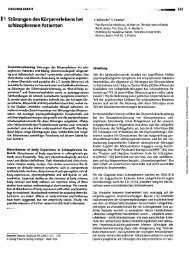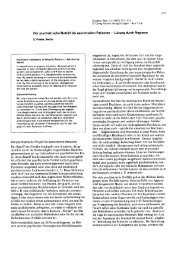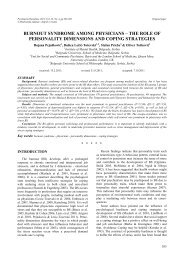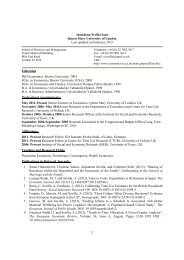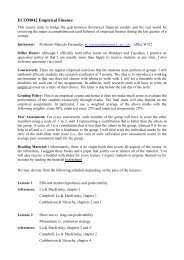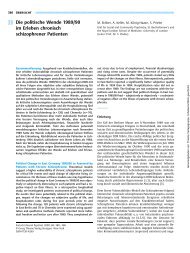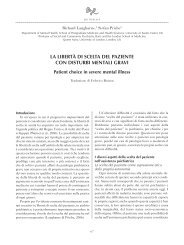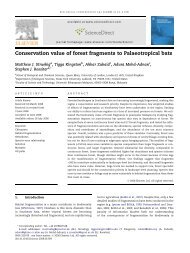Proofs - Personal Webspace for QMUL - Queen Mary, University of ...
Proofs - Personal Webspace for QMUL - Queen Mary, University of ...
Proofs - Personal Webspace for QMUL - Queen Mary, University of ...
You also want an ePaper? Increase the reach of your titles
YUMPU automatically turns print PDFs into web optimized ePapers that Google loves.
Studies in some European countries have shown that immigrants<br />
tend to make more use <strong>of</strong> emergency departments than<br />
national born populations do [3,30,34]. Secondary or tertiary<br />
services, such as mental health services [24,26], tend to be used to<br />
a lesser extent by immigrant patients. For this study, data records<br />
were either too fragmented or totally missing in the majority<br />
<strong>of</strong> cases <strong>for</strong> previous fi ndings to be compared with our dataset.<br />
Our study was able to suggest that telephone interpreting<br />
services were more frequently used in emergency departments,<br />
a fi nding confi rmed in previous studies. Leman [25] pointed out<br />
that telephone interpreting services were more appropriate <strong>for</strong><br />
emergency departments <strong>for</strong> their immediate availability and 24<br />
hour coverage. He stated that there has been an enormous ef<strong>for</strong>t<br />
in the UK to improve telephone interpreting services, especially<br />
<strong>for</strong> emergency departments [25]. Our data extends this fi nding<br />
somewhat to other European countries. However, several<br />
countries did not provide any <strong>for</strong>m <strong>of</strong> telephone interpreting<br />
services in any <strong>of</strong> the three types <strong>of</strong> health services included<br />
in this study. The impact <strong>of</strong> the missing payment regulations<br />
in some <strong>of</strong> the participating countries might have been one <strong>of</strong><br />
the reasons <strong>for</strong> the lack <strong>of</strong> interpreting services in some <strong>of</strong> the<br />
services assessed [5,16].<br />
7.3. Strengths and Limitations<br />
This study had a wide scope, including service providers from<br />
three different types <strong>of</strong> services in 16 European countries. The<br />
collaboration <strong>of</strong> partners from different European countries, and<br />
research centres, was regarded as an advantage when collecting<br />
data from local health services. However, the limited availability<br />
<strong>of</strong> suitable data in these services restricted the analyses that could<br />
be conducted on this dataset. Collecting data simultaneously in<br />
multiple countries also had its limitations, especially when local<br />
factors, such as the defi nition <strong>of</strong> an immigrant, differ from country<br />
to country [17]. Considerable design and planning was required<br />
to produce consistent assessment tools, agreement on defi nitions<br />
<strong>of</strong> the several immigrant groups, the types <strong>of</strong> services studied,<br />
as well as providing training <strong>of</strong> interviewers across countries<br />
to ensure consistent data collection <strong>for</strong> comparative analyses.<br />
Despite the ef<strong>for</strong>ts to ensure consistency <strong>of</strong> study procedures,<br />
a degree <strong>of</strong> variation should be taken into account in line with<br />
national variations on local policy and health service practice.<br />
Furthermore, only a small fraction <strong>of</strong> the total number <strong>of</strong><br />
service providers in each country was included in this study. By<br />
singling out services situated in the largest cities, in areas with<br />
the highest proportion <strong>of</strong> immigrants among the population, we<br />
encountered the services with the most challenges in the provision<br />
<strong>of</strong> health services to immigrants. The fi ndings presented<br />
here as a consequence, would most probably misrepresent the<br />
situation in rural services and services in smaller urban areas.<br />
7.4. Implications<br />
A better knowledge base and further scoping studies are<br />
required on the use <strong>of</strong> health services by immigrant patients<br />
<strong>for</strong> valid conclusions to be drawn at the national level in most<br />
U. Kluge et al. / European Psychiatry 27 (2012) / supplement n°2 / S56-S62 S61<br />
European countries. An obvious next step would be to relate<br />
national data on the use <strong>of</strong> health services by immigrants, to<br />
percentages <strong>of</strong> immigrants located in areas served by these<br />
services.<br />
Although interpreting services were regarded as one<br />
<strong>of</strong> the most important elements <strong>of</strong> appropriate health care<br />
delivery <strong>for</strong> many immigrant patients in the literature [7,8],<br />
several European countries have yet to take steps to implement<br />
such services. Provisions <strong>for</strong> covering the costs <strong>of</strong><br />
interpreting services are rare; the absence <strong>of</strong> such provisions<br />
in countries like Germany is one factor contributing towards<br />
the low availability <strong>of</strong> interpreting services [21]. By contrast,<br />
in Sweden where the costs <strong>of</strong> interpretation are covered by<br />
the government [9], there is a high level <strong>of</strong> interpreting service<br />
availability. Such variations are likely to have an impact on<br />
both the utilization <strong>of</strong> services and their quality in terms <strong>of</strong><br />
patient satisfaction. Due to recent cut backs in the fi nancing <strong>of</strong><br />
interpreting services, as had been the case in the Netherlands,<br />
the development <strong>of</strong> such services across European countries<br />
might be on the decline.<br />
The discussion on the employment <strong>of</strong> staff with immigrant<br />
backgrounds needs to be in<strong>for</strong>med by the extent to which immigrants<br />
use certain health services, and whether the employment<br />
<strong>of</strong> staff from immigrant backgrounds actually increases integration,<br />
sharing <strong>of</strong> cultural practices, and acceptance <strong>of</strong> immigrants<br />
into mainstream services and society. Also, previous papers from<br />
the EUGATE project have suggested advantages <strong>for</strong> both the<br />
inclusion <strong>of</strong> qualifi ed staff from immigrant backgrounds, and<br />
the training <strong>of</strong> all health service staff on cultural sensitivity and<br />
the specifi c needs <strong>of</strong> immigrant patients [6].<br />
Summarising the data presented in this paper, there is still<br />
a lack <strong>of</strong> general good quality data within health services on<br />
the use and service provisions <strong>for</strong> immigrant patients across<br />
European countries. Notwithstanding, some differences do<br />
exist between countries and different types <strong>of</strong> health service.<br />
The fi ndings presented here do increase the knowledge base<br />
somewhat <strong>for</strong> services providing health care in areas densely<br />
populated with immigrants, particularly on the availability<br />
and use <strong>of</strong> interpreting services and employment <strong>of</strong> staff with<br />
immigrant backgrounds.<br />
<strong>Pro<strong>of</strong>s</strong><br />
Confl ict <strong>of</strong> interest statement<br />
None.<br />
References<br />
[1] Ahmad W, Kernohan E, Baker M. Patients’ choice <strong>of</strong> general practitioner:<br />
infl uence <strong>of</strong> patients’ fl uency in English and the ethnicity and sex <strong>of</strong> the<br />
doctor. J Roy Coll GP 1989;39:153- 5.<br />
[2] Bisch<strong>of</strong>f A, Bovier P, Isah R, Francoise G, Ariel E, Louis L. Language barriers<br />
between nurses and asylum seekers: their impact on symptom reporting<br />
and referral. Soc Sci Med2003;57:503- 12.<br />
[3] Borde T, Braun T, David M. Unterschiede in der Inanspruchnahme<br />
klinischer Notfallambulanzen durch deutsche Patienten/innen und<br />
Migranten/innen. Schlussbericht für das BMBF Berlin: Humboldt-<br />
Universität Berlin, Universitätsmedizin Charité2003;61.<br />
[4] Claassen D, Ascoli M, Berhe T, Priebe S. Research on mental disorders<br />
and their care in immigrant populations: a review <strong>of</strong> publications from<br />
Germany, Italy and the UK. European Psychiatry2005;20(8):540- 9.




